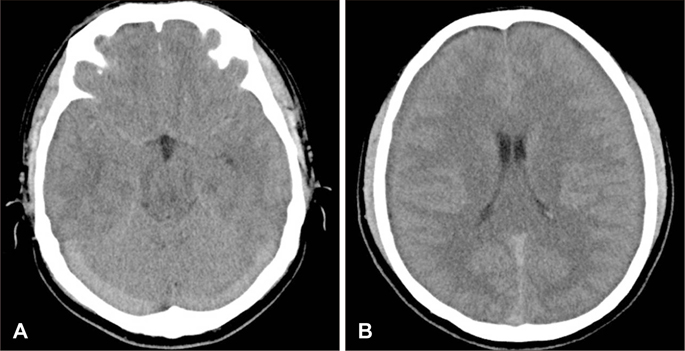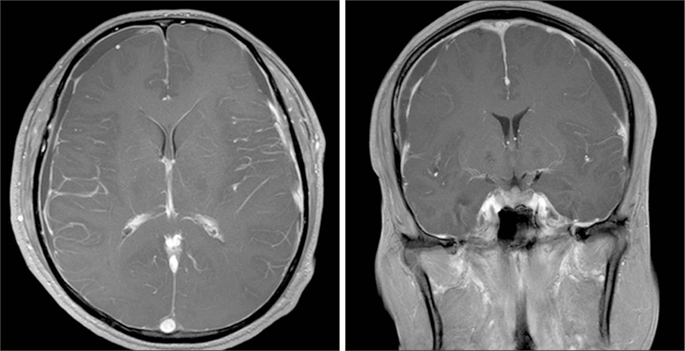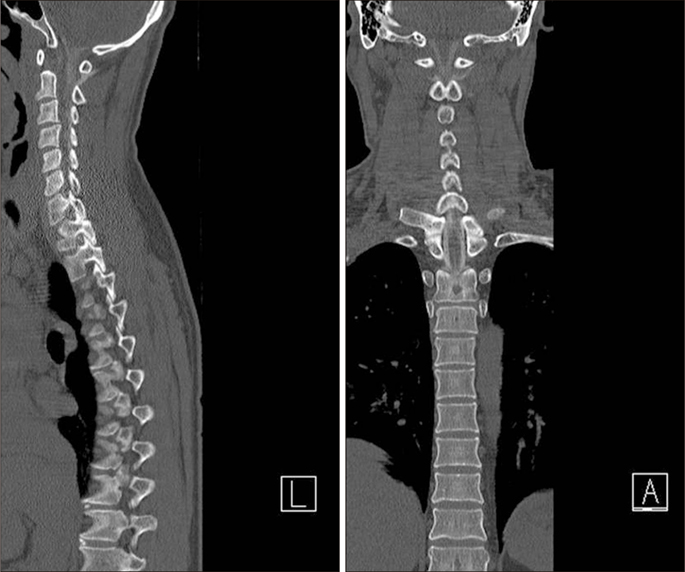J Korean Neurotraumatol Soc.
2011 Apr;7(1):35-38. 10.13004/jknts.2011.7.1.35.
Spontaneous Intracranial Hypotension, a Possible Cause of Chronic Subdural Hematoma
- Affiliations
-
- 1Department of Neurosurgery, Guro Hospital, Korea University College of Medicine, Seoul, Korea. ns806@kumc.or.kr
- KMID: 1427651
- DOI: http://doi.org/10.13004/jknts.2011.7.1.35
Abstract
- Although spontaneous intracranial hypotension were previously thought to be rare, they are now documented with increasing incidence by work up using advanced imaging techniques. We report our experience of CSF hypovolemia syndrome presented with chronic subdural hematoma on 37-years old young adult who had no traumatic history. Even spontaneous intracranial hypotension is not rare but it remains misdiagnosed. Causes of chronic subdural hematoma is generally trauma, but we need to consider this etiology of possible cause of chronic subdural hematoma, especially if young adult who had no trauma history complainted head ache and there was chronic subdural hematoma on brain CT.
Keyword
MeSH Terms
Figure
Reference
-
1. Albayram S, Wasserman BA, Yousem DM, Wityk R. Intracranial hypotension as a cause of radiculopathy from cervical epidural venous engorgement: case report. AJNR Am J Neuroradiol. 2002; 23:618–621.2. Chung SJ, Kim JS, Lee MC. Syndrome of cerebral spinal fluid hypovolemia: clinical and imaging features and outcome. Neurology. 2000; 55:1321–1327.
Article3. Chung SJ, Lee JH, Kim SJ, Kwun BD, Lee MC. Subdural hematoma in spontaneous CSF hypovolemia. Neurology. 2006; 67:1088–1089.
Article4. Headache Classification Committee of the International Headache Society. Classification and diagnostic criteria for headache disorders, cranial neuralgias and facial pain. Cephalalgia. 1988; 8:Suppl 7. 1–96.5. Davenport RJ, Chataway SJ, Warlow CP. Spontaneous intracranial hypotension from a CSF leak in a patient with Marfan's syndrome. J Neurol Neurosurg Psychiatry. 1995; 59:516–519.
Article6. Evan RW, Mokri B. Spontaneous intracranial hypotension resulting in coma. Headache. 2002; 42:159–160.
Article7. Hong JT, Lee SW, Son BC, Sung JH, Yang SH, Kim IS, et al. Analysis of anatomical variations of bone and vascular structures around the posterior atlantal arch using three-dimensional computed tomography angiography. J Neurosurg Spine. 2008; 8:230–236.
Article8. Kitchel SH, Eismont FJ, Green BA. Closed subarachnoid drainage for management of cerebrospinal fluid leakage after an operation on the spine. J Bone Joint Surg Am. 1989; 71:984–987.
Article9. Mokri B. Spontaneous cerebrospinal fluid leaks: from intracranial hypotension to cerebrospinal fluid hypovolemia--evolution of a concept. Mayo Clin Proc. 1999; 74:1113–1123.
Article10. Schievink WI, Maya MM, Louy C. Cranial MRI predicts outcome of spontaneous intracranial hypotension. Neurology. 2005; 64:1282–1284.
Article11. Yousry I, Förderreuther S, Moriggl B, Holtmannspötter M, Naidich TP, Straube A, et al. Cervical MR imaging in postural headache: MR signs and pathophysiological implications. AJNR Am J Neuroradiol. 2001; 22:1239–1250.
- Full Text Links
- Actions
-
Cited
- CITED
-
- Close
- Share
- Similar articles
-
- Delayed-Onset Subdural Hematoma and Oculomotor Nerve Palsy After Improving Spontaneous Intracranial Hypotension
- A Case of Spontaneous Intracranial Hypotension with Subdural Hematoma Mimicking Meningitis
- Unintended Complication of Intracranial Subdural Hematoma after Percutaneous Epidural Neuroplasty
- Chronic Subdural Hematoma after Spontaneous Intracranial Hypotension : A Case Treated with Epidural Blood Patch on C1-2
- Extended Pneumocephalus after Drainage of Chronic Subdural Hematoma Associated with Intracranial Hypotension : Case Report with Pathophysiologic Consideration




